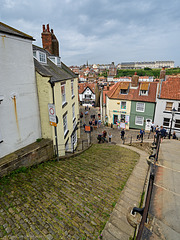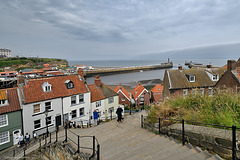
Coastal UK
Curve (HFF Everyone)
| |
|
|
|
This short length of fence forms part of the Marine Drive/Royal Albert Drive seawall. The wall runs the 1.6 mls (2.57 km) from North Bay to South Bay around the promontory upon which Scarborough Castle stands.
Cruising
Home with the catch
| |
|
|
|
Nordstjernen (North Star) GY1477 (Registered Grimsby) returning to Scarborough.
Leona waiting for the flood tide
| |
|
|
|
Sleipner reflection (PiP only)
| |
|
|
|
Sleipner Bow (PiP only)
| |
|
|
|
Yacht Sleipner
| |
|
|
|
Built in Denmark at Nils Dyrebor Boatyard 1988 as a yacht/cruiser, using larch over oak with teak topside.
In Norse mythology, Sleipnir /ˈsleɪpnɪər/ (Old Norse: [ˈslɛipnez̠]; "slippy" or "the slipper") is an eight-legged horse ridden by Odin.
Kinness Burn reflections
| |
|
|
|
Kinness Burn and St. Andrews Harbour
| |
|
|
|
Coble - Sea Salt (HFF Everyone)
| |
|
|
|
The blue and white boat on the sand is a recently rescued and refurbished traditional local Fishing Coble that was built in 1963. ‘Sea Salt' regularly leaves Whitby Harbour to harvest the sea salt which in turn will help to preserve this valuable, traditional wooden fishing boat for generations to come.
The coble is a type of open traditional fishing boat which developed on the North East coast of England. The southernmost examples occur around Hull, the type extends to Burnmouth just across the Scottish border.
The distinctive shape of the boat — flat-bottomed and high-bowed — arose to cope with the particular conditions prevalent in this area. Flat bottoms allowed launching from and landing upon shallow, sandy beaches; an advantage in this part of the coast where the wide bays and inlets provided little shelter from stormy weather. However, fishermen required high bows to sail in the dangerous North Sea and in particular to launch into the surf and to land on the beaches. The design contains relics of Norse influence, though in the main it shows Dutch origin.
Local boat-builders constructed the clinker-built cobles locally as required, without the use of plans. The craftsmanship on many boats gave them a long working life. They had a reputation as dangerous to sail for an inexperienced crew, but in the hands of experts could move both safely and speedily.
Today, surviving cobles generally use diesel engines, removing the need for the distinctively shaped lug sail.
The fossil hunters
| |
|
|
|
On Whitby Scar below the Abby Headland
Whitby is on a coastal stretch known as the 'Dinosaur Coast' or the 'Fossil Coast', the area is around 35 miles (56 km) long and stretches from Staithes in the north and south to Flamborough. At Whitby dinosaur footprints are visible on the beach. The rock strata contain fossils and organic remains including jet. Fossils include the petrified bones of an almost complete crocodile and a specimen of plesiosaurus measuring 15 feet 6 inches (4.72 m) in length, and 8 feet 5 inches (2.57 m) in breadth was discovered in 1841.
Smaller fossils include numerous species of ammonites, or "snake stones", from the Whitby Mudstone Formation (Alum Shale Member) and at Whitby Scar nautiloids in the lower beds of the lias strata. The town's "snakestones" folklore (similar to Keynsham's in Somerset) has it that fossils were once living serpents that were common in the area. This was until the 7th century AD when Anglo-Saxon Abbess St Hilda of Whitby (614–680), first had to rid the region of snakes. She did so by casting a spell that turned them to stone and then threw them from the cliff tops.
Tate Hill beach, Whitby harbour
| |
|
|
|
Tate Hill is a small, sandy beach located on the eastern side of the sheltered harbour.
Whitby Harbour and Tate Hill beach at low tide
A welcome sight! (see note)
| |
|
|
|
Church Lane and the Church Steps converge at the bottom of the hill below St. Mary's Church and Whitby Abbey Ruins.
Harbour mouth and piers from the Abbey Steps (HFF…
| |
|
|
|
The two piers in Whitby have been in existence since before the 1500's. By 1540, the two oak piers (east and west) were replaced partially, with stonework (in the reign of King Charles 1), with further work around the 1600's. Both piers were rebuilt in 1735, each measuring approximately 183m, but by 1814 the west pier was further extended to reach a length of 309m. In 1905, both the piers had new pier ends built on, each of a length of 152m.
The west pier lighthouse was built in 1831, and is a stone 83 feet column tower with a lantern on top. This light still displays a green light when shipping is expected. This lighthouse was replaced in 1914, by a wooden framework tower on 'legs, located at the seaward end of the new pier extension.
Whitby East Pier Light (or Whitby East Breakwater Light), was built in 1854. The stone built lighthouse stands 55 foot high ( approx 16 mtrs) and had a light visible from 8 miles (approx 13 km).
This too was replaced in 1914, by the new Whitby east pier light. The new light was built as a wooden framework tower on 'legs', again at the seaward end of the new pier extension. Currently operational, it displays an automated fixed red light (red for port).
Resting place at the top (HBM everyone)
| |
|
|
|
One of the most famous landmarks in Whitby are the 199 steps that lead up from the Harbour area to St Mary’s church, also know as the ‘Church Steps’.
The first record of the steps was in 1340, though it is believed the steps were made a long time before this, as some historians believe that St Hilda would use the steps to test the faith of her followers (climbing up the steps would prove your faith, a simple task these days).
The steps were originally made of wood and stood for hundreds of years that way until 1774 when the steps were replaced with stone. There has been many years of dispute as to how many steps there are, some believe there are 198, and others believe 200 (depending on how you count the steps).
Before the 19th century, when St Mary’s was still open for burials, many people preferred to be carried up the steps, rather than giving their relatives a more easy journey and having their bodies carried in a horse and carriage along a lane leading to the church. It must have been extremely tiring carrying a body up 199 steps, so wooden planks were built in place to place the coffin on and give the pall-bearers a rest (they are now used as benches for the living to rest on).
Scarborough Harbour
| |
|
|
|
Calm Morning
Jump to top
RSS feed- Latest items - Subscribe to the latest items added to this album
- ipernity © 2007-2024
- Help & Contact
|
Club news
|
About ipernity
|
History |
ipernity Club & Prices |
Guide of good conduct
Donate | Group guidelines | Privacy policy | Terms of use | Statutes | In memoria -
Facebook
Twitter


















